Mythbusting: A 5-Point Harness Is Safer Than A Booster Seat for Older Kids
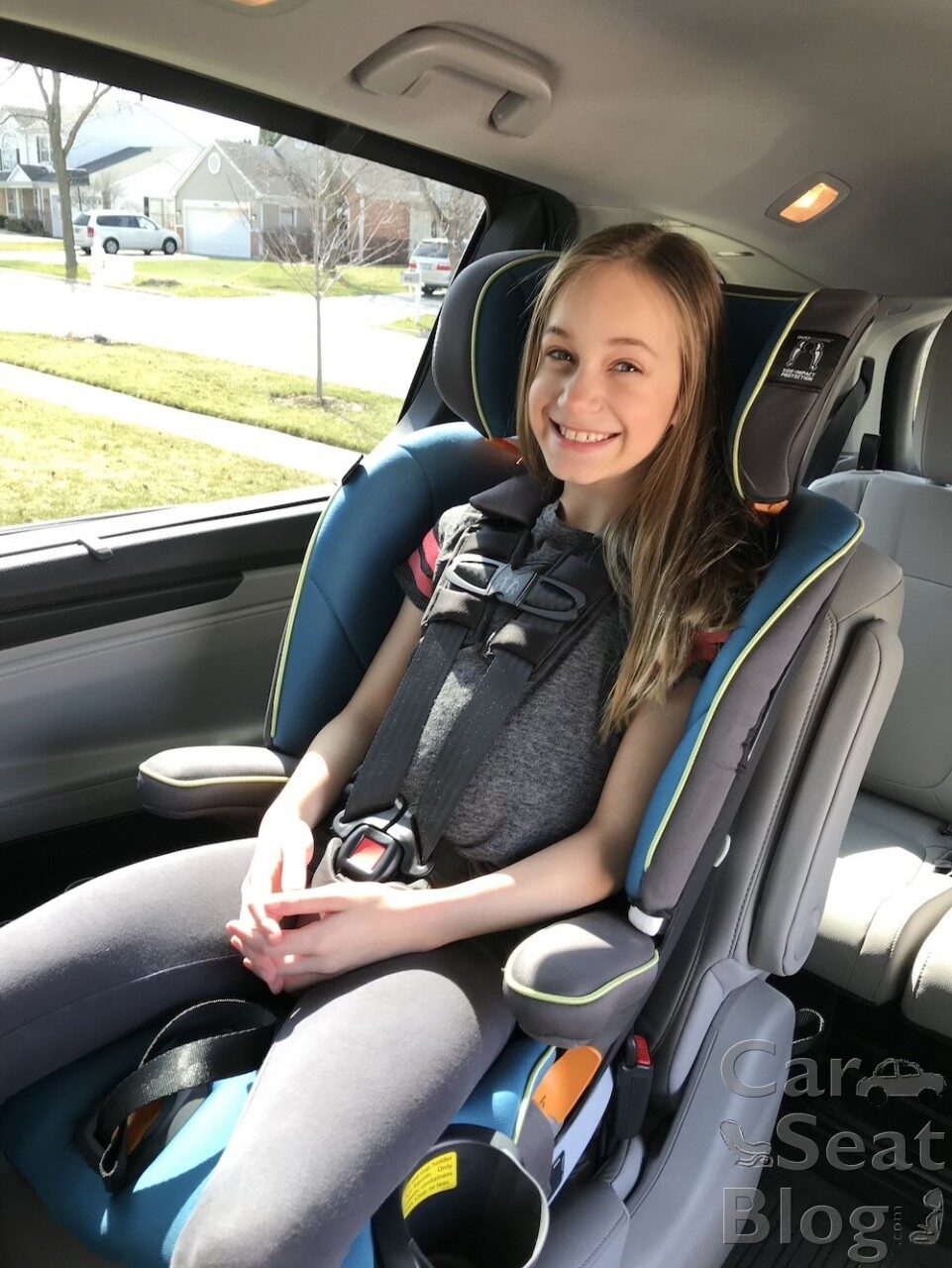
![]()
![]()
![]()
![]()
![]()
Is a 5-point harness safer than a booster seat and seatbelt for an older child?
 It’s a question that has been asked ever since the introduction of car seats with a higher-weight harness in the early 2000’s. To this day, there still hasn’t been a consensus in the field, either way, so we’ll take a look at the evidence and try to come to a conclusion. No promises that we’ll find a real answer though.
It’s a question that has been asked ever since the introduction of car seats with a higher-weight harness in the early 2000’s. To this day, there still hasn’t been a consensus in the field, either way, so we’ll take a look at the evidence and try to come to a conclusion. No promises that we’ll find a real answer though.
Myth: Even for School-Age Kids, a Car Seat with a 5-Point Harness Is Always Safer than a Booster Using a 3-Point Lap/Shoulder Seatbelt
So right off the bat, I want to make a few points. When I say “always”, I mean for neurotypical, booster-age children (let’s say age 5 and up) who weigh at least 40 lbs. but still fit in a harnessed car seat. It’s established that 5-point harnesses are safer for children under 40 lbs. and for kids who cannot sit in the proper position for an entire car ride, but for mature school-age children, we need to look at the evidence to see if there’s an advantage either way.
First, let’s look at the studies that have compared properly fitting seat belts (meaning in a booster for kids age 5 and up) and 5-point harnesses in similar crash circumstances:
….
That’s right, there aren’t any. Zip, zilch, zero. So that will make this a bit more challenging.
There are a number of studies that compare children in 5-point harnesses to seat belts alone and a number that compare children in belt-positioning boosters to seat belts alone, and even one Canadian study that compared boosters with a 5-point harnessed seat but with a dummy that was heavier than the weight limit of the harness. But none that compare children in 5-point harnesses to children in belt-positioning boosters for older kids. One study did show a modest benefit of a 5-point harness over boosters for 3-year olds, but showed much smaller benefits for 4-year olds and concluded, “The results for any type of injury support the recommendation for graduation at 4 years or about 40 pounds in general, although it may be the case that more severe injuries are better prevented by CRS (Child Restraint System with harness) even at 4 years old.”
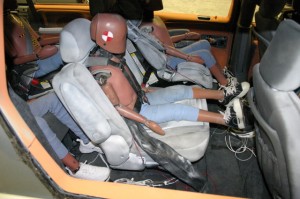
Photo Credit: Transport Canada
So despite the past research, we don’t have any firm evidence to tell us whether older kids (5+) are safer in boosters vs. forward-facing 5-point harnesses. I’m sure it will be no surprise that in the studies that exist, both 5-point harnesses and high back belt-positioning boosters both reduce the risk of injuries to children as compared to seat belts alone. But that doesn’t help us here.
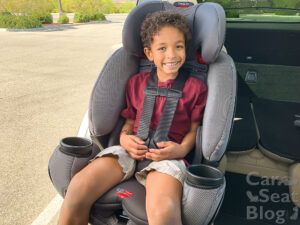
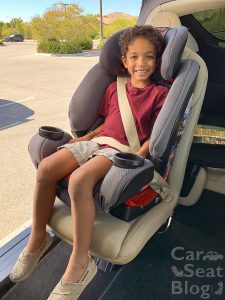
So we’ll take a step back and look at the established pros and cons of each restraint type.
5-point Harness (forward-facing):
Pros:
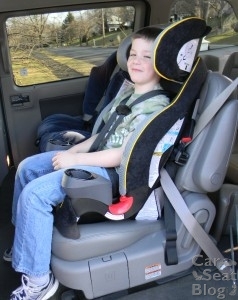 When used correctly, they almost completely eliminate the risk of ejection in all types of crashes.
When used correctly, they almost completely eliminate the risk of ejection in all types of crashes.
They disperse the crash forces over more areas of the body, which equals less force in each area.
They keep a child optimally positioned throughout a car ride, even when asleep.
They have a tether that reduces forward head excursion (as compared with non-use of tether).
Cons:
The harnessed seat must be installed properly with less than one inch of movement and tethered for maximum effectiveness
The harness straps must be appropriately tightened (to pass the pinch test), otherwise, the child will experience greater head excursion – increasing the chances that the head will strike something inside the vehicle
The harness has a weight limit and a height limit that must not be exceeded
In holding the body against the seat, the neck may incur increased forces in a frontal crash
Belt-Positioning Booster with 3-point Lap/Shoulder Belt:
Pros:
 Seatbelt retracts on its own, so there’s less risk of it being too loose
Seatbelt retracts on its own, so there’s less risk of it being too loose
No complicated installation process
No weight limit on seatbelts
Backless boosters will have less head excursion in frontal crashes simply because the head is starting off in a more rearward position initially
A lap/shoulder seatbelt allows the neck and spine to move together more easily (compared to 5-pt harness)
Cons:
Kids can move out of optimal position easily and frequently, especially while sleeping or leaning forward to look at a device
Some booster seats don’t have LATCH to hold them in place while loading or unoccupied
More variables involved (as compared to properly used 5-pt harness) that cannot be accounted for pre-crash. Example: At what point in the crash sequence does the retractor lock? Does the child “roll out” of the shoulder belt during the crash? Does the child submarine under the lap belt?
Seatbelts provide fewer points of restraint with the body, which may mean a greater chance of head excursion, ejection, and submarining in severe crashes. Especially a concern in far-side impacts, rollovers, and multi-impact crashes.
Well. That didn’t really help much, now did it?
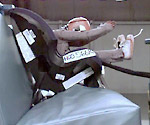 We unquestionably need more investigation on head/neck forces in 5-point harnesses versus 3-pt seatbelt. When a body is harnessed into a seat, the only real free movement comes above and below the harness- so we see the neck snap forward (why rear-facing is recommended for younger kids) and the arms and legs go flying forward. It’s a lot of pressure on the neck, which isn’t ideal for children before their spine is fully ossified (converted from cartilage to bone).
We unquestionably need more investigation on head/neck forces in 5-point harnesses versus 3-pt seatbelt. When a body is harnessed into a seat, the only real free movement comes above and below the harness- so we see the neck snap forward (why rear-facing is recommended for younger kids) and the arms and legs go flying forward. It’s a lot of pressure on the neck, which isn’t ideal for children before their spine is fully ossified (converted from cartilage to bone).
In a seatbelt, there is more rotational movement of the body around the shoulder belt, which may, theoretically, reduce the forces acting on the head and neck because the spine is also moving. What we don’t know is if it’s a meaningful decrease in neck forces or if this theory even pans out in real life, especially for older kids. And, even if there is a meaningful decrease in neck forces in a 3-pt seatbelt, is it significant enough to offset an increased risk of ejection or partial ejection in a booster – especially in side impacts and rollovers?
So, I realize this is anticlimactic, but:
BUSTED, PLAUSIBLE OR CONFIRMED?
Ummmmm, PLAUSIBLE?

There’s no real answer here, which is as frustrating for me as it is for you, I can assure you. I think the big takeaways are:
Children who cannot sit properly in a seatbelt through an entire car ride (even when asleep) NEED to be in a 5-point harness, even if we find out that seatbelts are better in some ways.
Proper use of both 5-point harnessed seats and belt-positioning boosters greatly reduce the risk of injury in a crash.
The type of crash (which cannot be predicted in advance) plays a big role in determining crash outcomes and some crash types like side-impacts, oblique-impacts, and rollovers usually have much worse outcomes than frontal and rear-impacts.
We need someone to really study this.
I promise to update when/if more information becomes available. In the meantime, I’d love to hear what other people have found when researching this themselves.







